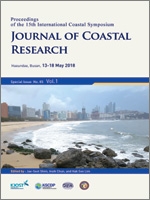S.B. Sujitha; M.P. Jonathan; D.C. Escobedo-Urias; Fernando Aguirre-Bahena; S.K. Sarkar; Lorena Elizabeth Campos Villegas, and E. González Gomez., 2018. Fate of dissolved trace metals in the waters of Bahia Magdalena lagoon, Baja California Sur, Mexico. In: Shim, J.-S.; Chun, I., and Lim, H.S. (eds.), Proceedings from the International Coastal Symposium (ICS) 2018 (Busan, Republic of Korea). Journal of Coastal Research, Special Issue No. 85, pp. 431–435. Coconut Creek (Florida), ISSN 0749-0208.
Concentrations of dissolved trace metals (Fe, Mn, Cr, Cu, Ni, Co, Zn, Cd, As) were determined in forty-one surface and forty bottom water samples procured from Bahia Magdalena lagoon, Baja California Sur, Mexico using an Atomic Absorption Spectrophotometry. In-situ measurements of temperature, salinity, dissolved oxygen and pH were also carried out in each station and high salinities classified the lagoon as Eurihaline. The region witness raised temperatures (avg. 28.92°C) due to their location in an arid setting with less precipitation (< 14mm) and high evaporation rates. The pH values ranged from 7.52 – 8.56 indicating an alkaline environment. Cadmium and Zinc presented nutrient like distributions whereas Fe, Mn, Co, Cu, Cr, Ni showed scavenged type of profiles. The high values of Ni (surface: 0.246 mg/L; bottom: 0.138 mg/L), As (surface: 0.224 mg/L; bottom: 0.228 mg/L), Co (surface: 0.125 mg/L; bottom: 0.122 mg/L) and Cd (surface: 0.018 mg/L; bottom: 0.016 mg/L) are due to the local influences such as the ophiolitic outcrops, upwelling process, hydrothermal fluids and submarine phosphatic deposits. Less concentrations of Fe in the surface 0.011 mg/L and bottom waters (0.007 mg/L) are attributed to the formation of insoluble Fe oxides and hydroxides in oxygenated waters. Moreover, the fate of metals is also determined by the plankton distributions present in the lagoon which release strong chelators that influence the bioavailability of trace metals. However, the levels of Ni and As were observed to be hundred fold higher than the recommended values (Ni: 0.002 mg/L, As: 0.0002 mg/L) set by the Mexican government posing severe threat to the biota. This study gives distinct evidence of the distribution of dissolved trace metals against which long term contamination status may be evaluated.





